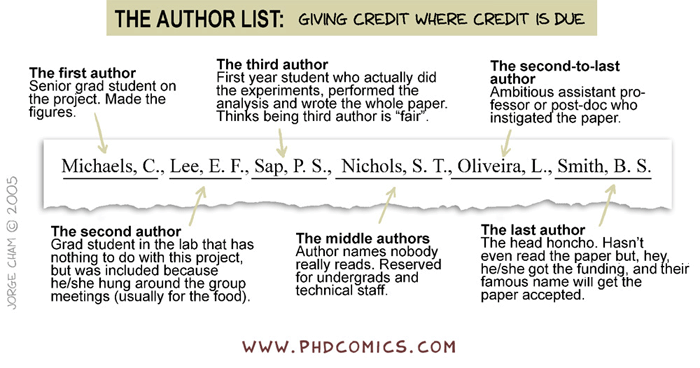Authorship Criteria

One of the most important tasks in science is disseminating your research through publications and presentations; therefore, authorship on these items is a crucial indicator of your role to the outside world. Authorship implies a significant contribution to a paper, such as intellectual ideas that shape the research or experimental contributions. Simply following instructions and not actively participating in the experimental design or interpretation will be acknowledged but likely would not result in authorship.
While the order of authors varies by specific field, in chemistry education research, the first author is generally the student or post-doc who took the lead and wrote the paper, the last author is the Principal Investigator (PI), and the authors in between are listed in order of decreasing contribution.
Authorship on papers is usually clear, but the grey area lies in determining when smaller contributions warrant authorship. All authors are expected to contribute to the project’s ideas. As a concrete proxy for such contributions, lab members should attend (and speak in) project meetings from the moment they are brought onto the project.
If someone inside or outside the lab is repeatedly asked for help and shows interest in the project, they can be brought on board as an author. If someone only assists with data collection without broader intellectual input, that usually warrants an acknowledgment in the paper, not authorship.
To ensure transparency for both authors and readers, every paper produced by the lab will include the use of CRediT (Contributor Roles Taxonomy). This taxonomy recognizes various contributions, such as:
| Term | Definition |
|---|---|
| Conceptualization | Ideas; formulation or evolution of overarching research goals and aims |
| Methodology | Development or design of methodology; creation of models |
| Software | Programming, software development; designing computer programs; implementation of the computer code and supporting algorithms; testing of existing code components |
| Validation | Verification of the overall replication/reproducibility of results/experiments and other research outputs |
| Formal Analysis | Application of statistical, mathematical, computational, or other formal techniques to analyze or synthesize study data |
| Investigation | Conducting a research and investigation process, specifically performing the experiments or data/evidence collection |
| Resources | Provision of study materials, reagents, materials, patients, laboratory samples, animals, instrumentation, computing resources, or other analysis tools |
| Data Curation | Management activities to annotate (produce metadata), scrub data, and maintain research data for initial use and later reuse |
| Writing – Original Draft | Preparation, creation, and/or presentation of the published work, specifically writing the initial draft |
| Writing – Review & Editing | Preparation, creation, and/or presentation of the published work, specifically critical review, commentary, or revision |
| Visualization | Preparation, creation, and/or presentation of the published work, specifically visualization or data presentation |
| Supervision | Oversight and leadership responsibility for the research activity planning and execution, including mentorship external to the core team |
| Project Administration | Management and coordination responsibility for the research activity planning and execution |
| Funding Acquisition | Acquisition of financial support for the project leading to the publication |
Importantly, the CRediT taxonomy is not intended to determine who qualifies as an author. Each author of an article may have one or more CRediT contribution roles, but having a role described by the taxonomy does not automatically qualify someone as an author. Authorship is still determined by the guidelines described at the beginning of this section.
References:
Image Credit: Ph.D. Comics
The CRediT taxonomy has been refined by Consortia Advancing Standards in Research Administration (CASRAI) and National Information Standards Organization (NISO). It is in adoption by Cell Press, PLOS and many other publishers, and has been integrated into some submission and peer review systems and research workflow tools.